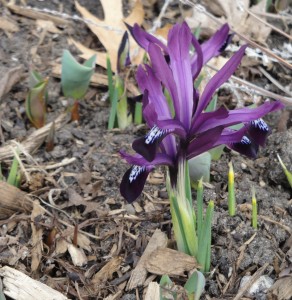The Value of Keeping Garden Records
A Facebook friend who is also a garden blogger posted about the explosion in websites that help people keep garden records. I’ve owned many garden journals and, for years, bought notebooks that I labeled “Garden” but I never really kept records well until I started blogging in 2007. Since then, the value of keeping garden records has hit home.
In a climate as variable as Minnesota’s, planting times, bloom times and harvest times can vary by weeks, so knowing the entire time range is helpful in planning and (most importantly) covering your bets so you don’t loose an entire crop to an unexpected frost.

Consider, for example, the case of Iris reticulata, a very early blooming bulb growing in my warmest front yard bed. In 2012, a year with multiple 70 and 80 degree days in March, it bloomed on March 15. In 2011, it was blooming April 4; in 2010 by March 25; in 2009, not until April 16. A full month of difference between the earliest and latest bloom is a lot, and indeed plants that bloom later in the season are more predictable. For instance, my blog notes peonies blooming in the last week or so of May almost every year. (In one year, it’s the first week of June.)
One benefit of records like these is that they moderate both our enthusiasms and our desolation. They tell us to hold off on putting those tomatoes in the ground until all danger of frost has past, even if that means June. They also remind us spring will come — eventually. We have not seen a 55 degree high where I live since Dec. 3 (and that was a fluke), so it has been a very long winter. My records remind me it will not last much longer, though I may have to wait until mid-April to see a flower bloom.
Do you keep garden records? How?
—Mary Lahr Schier
